Standard Liège are historically one of Belgium’s most decorated clubs, with 10 league titles, eight national cups, and a European final appearance to their name over their long 126-year history.
But since their last top-five finish in 2019/20, the club has had a turbulent ride.
They have failed to qualify for Europe ever since, marking this as their longest continental drought in over thirty years.
So far this season, under Ivan Leko’s tactics, they aren’t faring much better, with the club currently sitting in ninth position in the Jupiler Pro League table.
But the most alarming part isn’t their league standing; it’s the amount of goals they’ve scored.
With 11 rounds played to date, Standard have struck the back of the net on only seven occasions, making them statistically the worst offensive team in the league as no one has scored less.
Not only that, but only three of their seven strikes have come from open play, with the rest arriving off of dead ball situations.
This tactical analysis and team-focused scout report will explore Standard Liège offensive tactics.
We will explore whether they’re just misfiring, whether these statistics indicate deeper issues on the field and whether the recent win over Charleroi is a sign that things will be alright at the Stade Maurice Dufrasne.
Standard Liège Data Analysis 2024/25
The first important step is to examine the available data more closely to understand Standard’s scoring problems.
Let’s start off by looking at what they do with the ball offensively when they have it.
Standard Liège Ball Progression Map
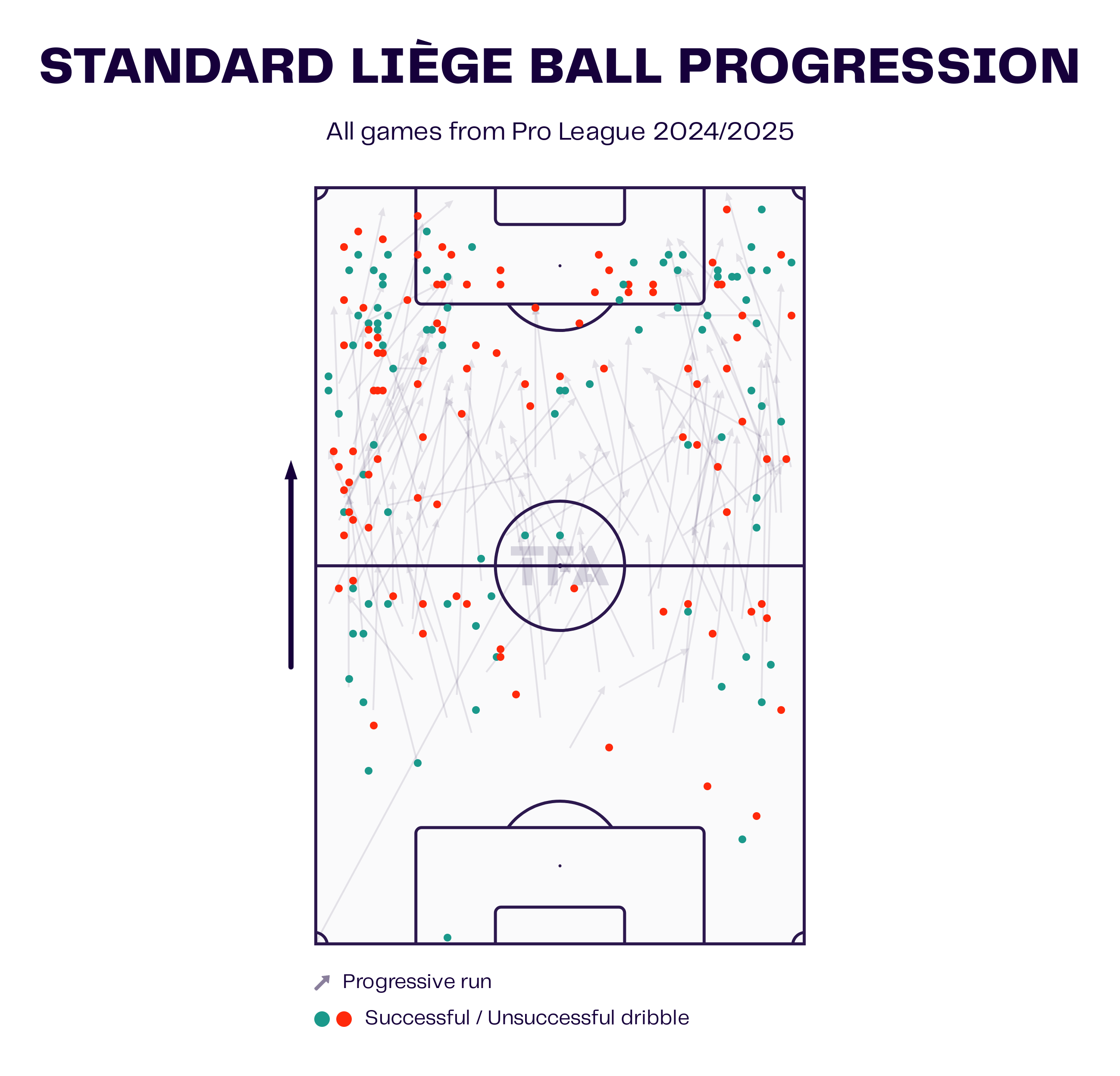
As the data viz above displays, most of Standard’s offensive activity clearly comes through the wider areas.
There’s very little coming through the central areas, which already suggests some issues within their midfield when it comes to finding attacking success.
Out wide, on both sides, they’ve found a moderate level of success in dividing successful dribbles by unsuccessful dribbles.
But let’s break that down further below.
Standard Liège Winger Actions Map
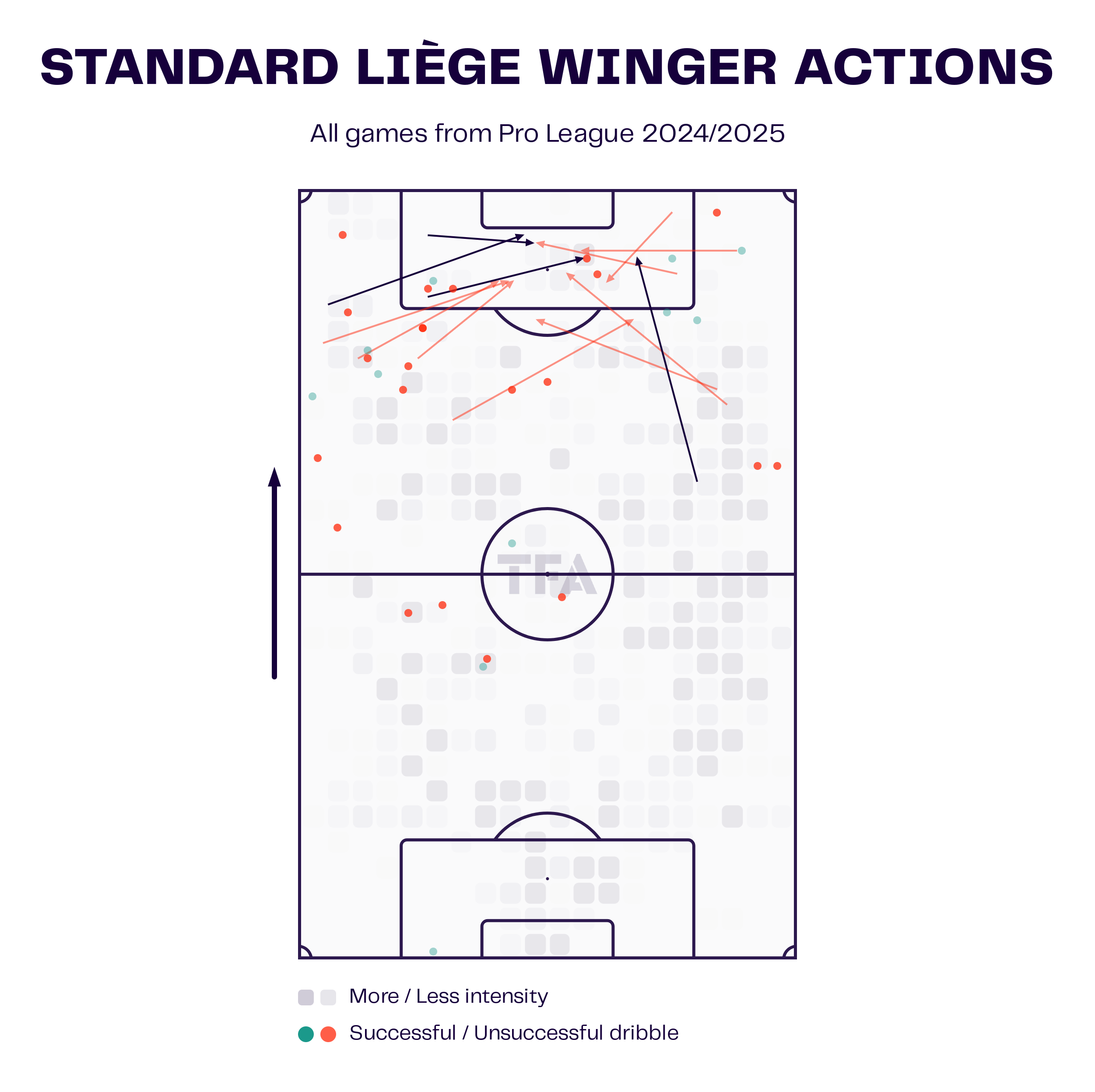
As this winger actions data viz shows, their offensive success comes in deeper areas on the flanks rather than in advanced situations.
The intensity of their actions are higher the deeper they are on the field instead of closer to where they can really trouble the opposition’s penalty area.
This adds up alongside the dribbling statistics of the main three players they’ve used in the wing-back positions.
These players are the most influential figures in these areas and are the sole consistent wide presences in their 5-3-2 shape this season.
Henry Lawrence has averaged 3.08 dribbles per game with a 63.2% success rate, Ilay Camara averages 4.29 dribbles with only a 39.4% success rate, and new USMNT international Marlon Fossey attempts just 1.45 dribbles with a 68.8% success rate.
So, on average, their wide players attempted less than a handful of dribbles each game, with a relatively okay success rate, and clearly, not many of them came in the attacking third, as the data viz displayed.
In addition, the overall team statistics of offensive duels won and accurate crosses into the box average around 30% per game, and it’s clear that what they are hoping to achieve offensively within their current tactical framework has not been working for them this season.
Now, let’s examine their performance in the aspect that most directly correlates to scoring goals: shooting.
Standard Liège Shots Map
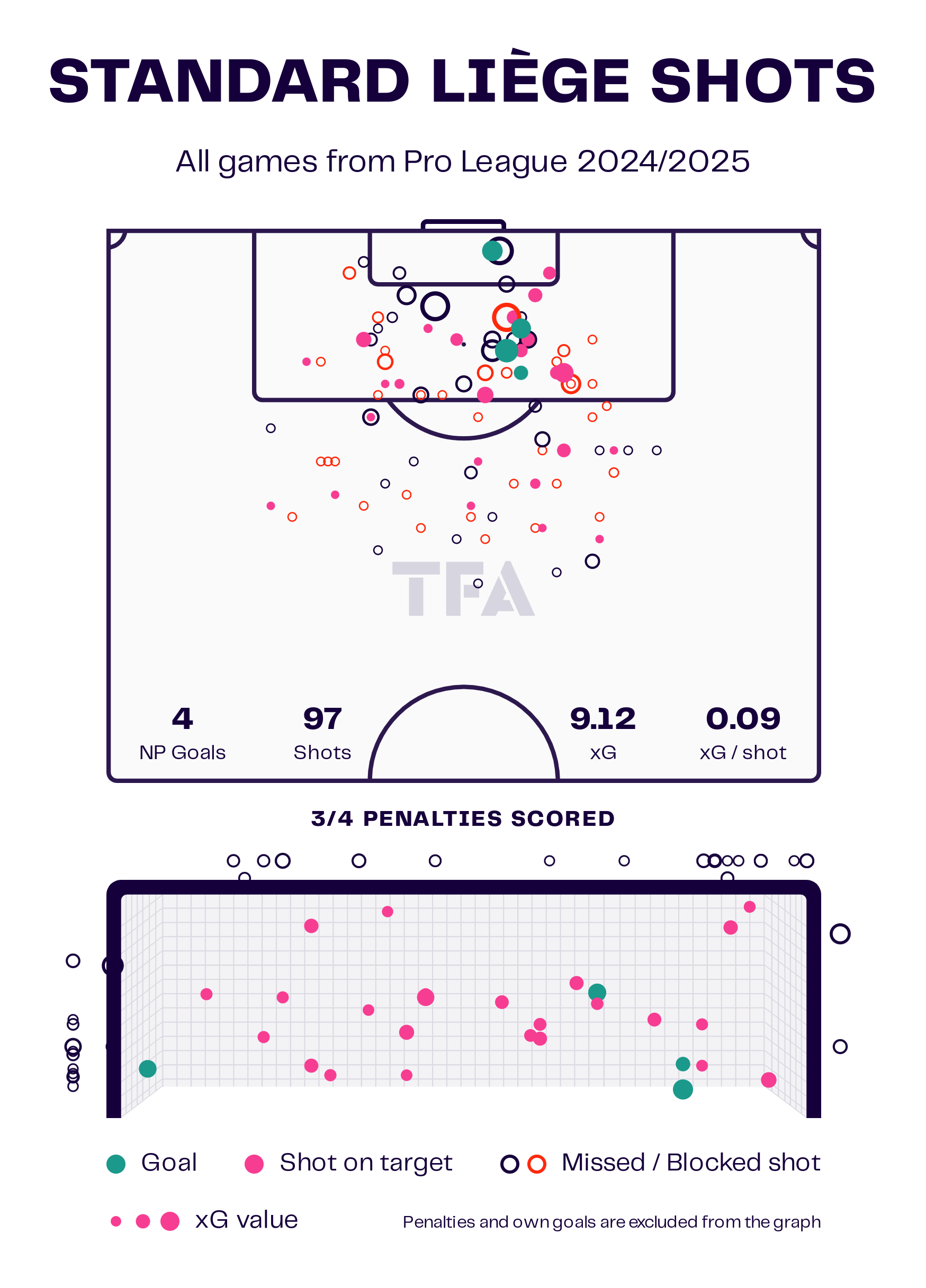
The data viz above shows both where Standard’s shots have been coming from this campaign and the xG value of those shots.
Overall, they’ve attempted 97 shots, with around half of them coming from outside the penalty area.
This will consistently deliver a low xG value rating regardless of the strike’s positioning.
With an average of a 0.09 xG value per shot, it’s no wonder that they’ve been struggling to score goals consistently or that their overall xG this season is less than a goal a game at 0.64.
They simply aren’t taking quality shots, and their overall shot selection is poor.
All in all, their wing play has been below par, their shot selection and scoring rate haven’t been up to standard (excuse the pun), and they are rock bottom as far as scoring goals goes in the league for a reason.
But what can give them some encouragement to improve their situation, perhaps, is their counter-pressing scheme.
Standard Liège High Regains Map
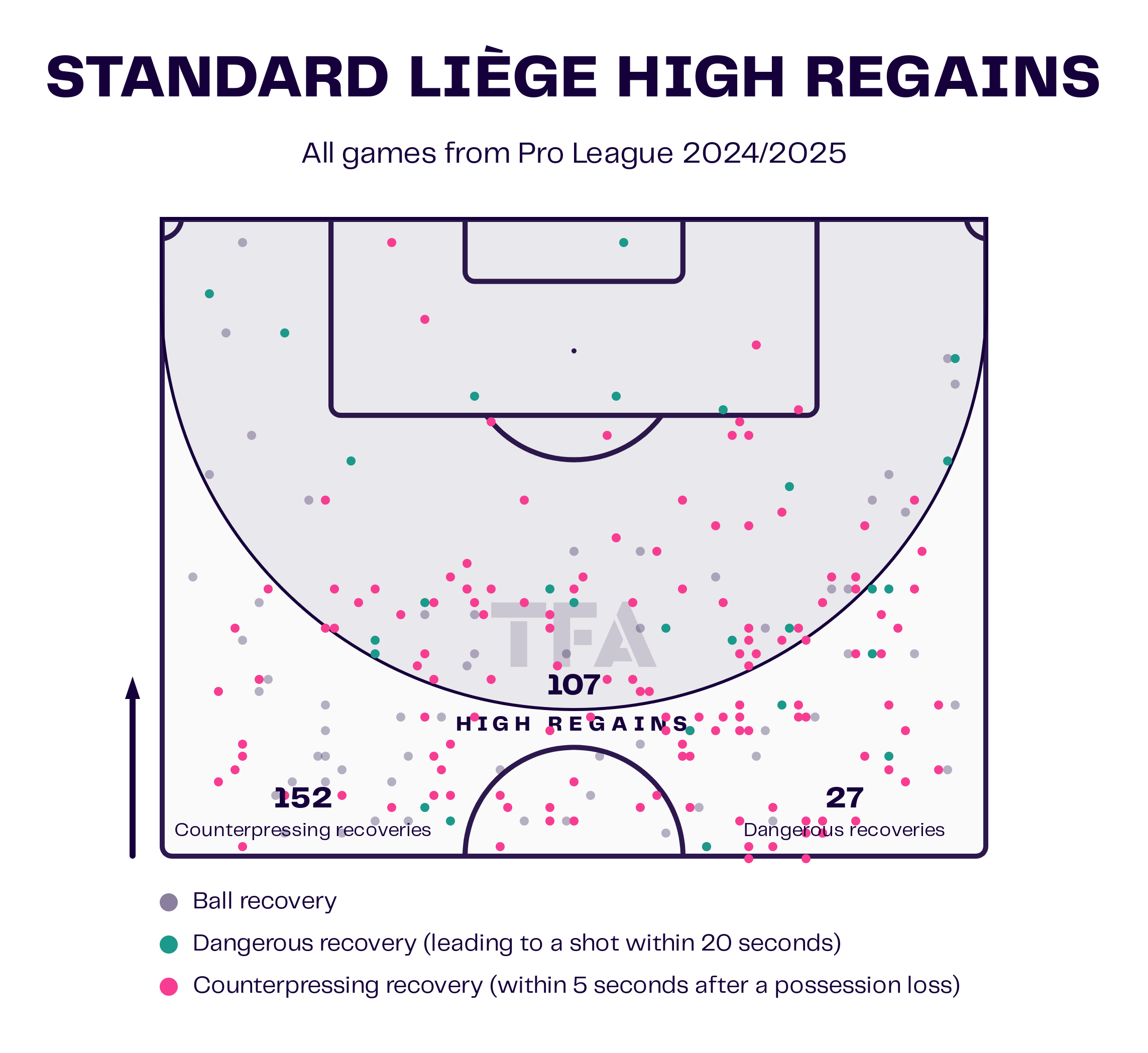
This season, Standard has averaged around 40% possession per game and has only out-possessed the opposition on one occasion, at home against Westerlo.
They aren’t a side that relies on their build-up play or inventive ideas when on the ball to create chances.
Under Ivan Leko’s managerial style, they are a counterattacking side.
Often, their best route to goal is allowing the opposition to have the ball and pressing them higher up the field in an attempt to win it back and end up closer to goal than they might have been otherwise.
As the data viz above shows, they have found success in their attempts to win the ball in the opposition half, even if it hasn’t yet materialized in as many goals as they’d like.
With over 150 counter-pressing recoveries and 100 high regains, they average about a dozen opportunities a game just from their abilities to regain possession in higher areas of the field.
All of them lead to attempts at goal ranging within five to twenty seconds.
In addition, Leko started off the season setting them up in a 5-4-1 scheme but has altered it somewhat by drafting in an extra striker to help with the team’s offensive problems in recent games.
Since then, they’ve managed to boost their strike rate up to a goal a game, and maybe that change, along with sustaining these sorts of figures out with their high regains, can lead to a turnaround offensively as the season wears on.
But it seems that this will require more than just winning balls back and playing extra attacking players.
Standard Liège Spacing Issues
As mentioned, under Ivan Leko’s style of play, Standard Liège is not a team that likes to dominate possession.
They would instead allow the opposition to have the ball and try to win it back from them in high areas.
Their goalkeeper, Matthieu Luka Epolo, is not known for his ball distribution.
In this team, he only averages about 23 passes per game.
At the same time, their main starting centre-back trio of Boško Šutalo, Ibe Hautekiet and David Bates also have a low average of around 15 forward passes each game.
So, given that the players they possess at the back are not the most comfortable or technically capable on the ball, this creates problems for them in the build-up phase, making it difficult for them to play out and progress plays within their own capabilities.
Another problem is the spacing issues that the team has with this current structure under Leko, which we can see examples of below.
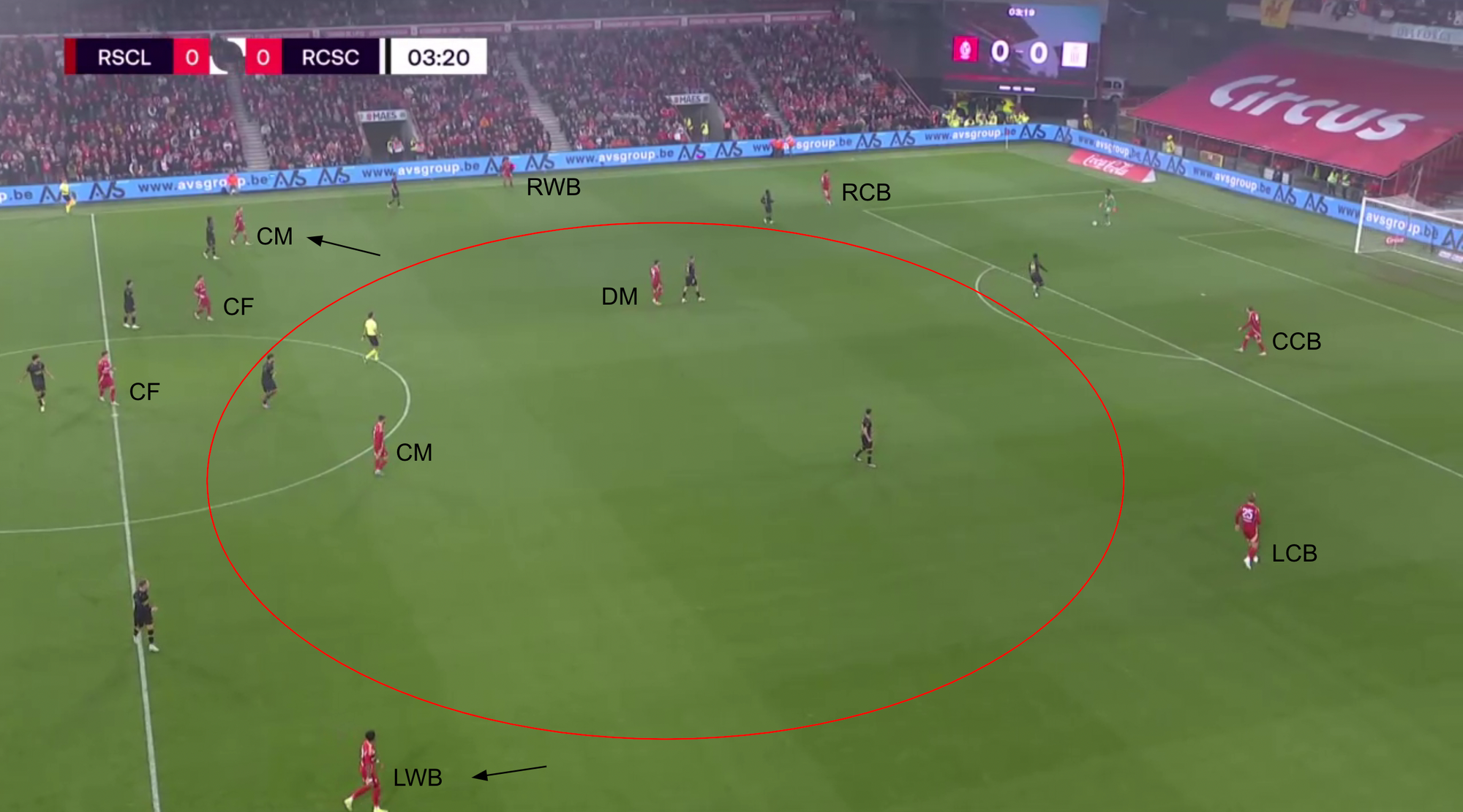
This example is from the last game at home against Charleroi.
As we can see with the red circle there, there is an ocean of space where Standard is lacking sufficient support in the build-up phase with only their defensive midfielder and captain, Aiden O’Neill, in a ‘normal’ position.
Their other central midfielders, Isaac Price and Marko Bulat, are more focused on making forward runs either side of the strikers up front and in between the wing-backs.
While this, in theory, has some logic from an offensive point of view in terms of trying to get the ball from back to front as quickly and directly as possible, it does not help Standard to create any sustainable patterns of play or possession on the ball.
With such large gaps between those at the back and the rest of the team, there are very limited options to play the ball out of the back, leaving them a lot of the time with only the choice to go out wide or long.
As we’ve already covered in this analysis, their wing-backs are not very aggressive or successful in taking on players when they do get the ball, so it’s not hard to see why this side are struggling to score with regularity.
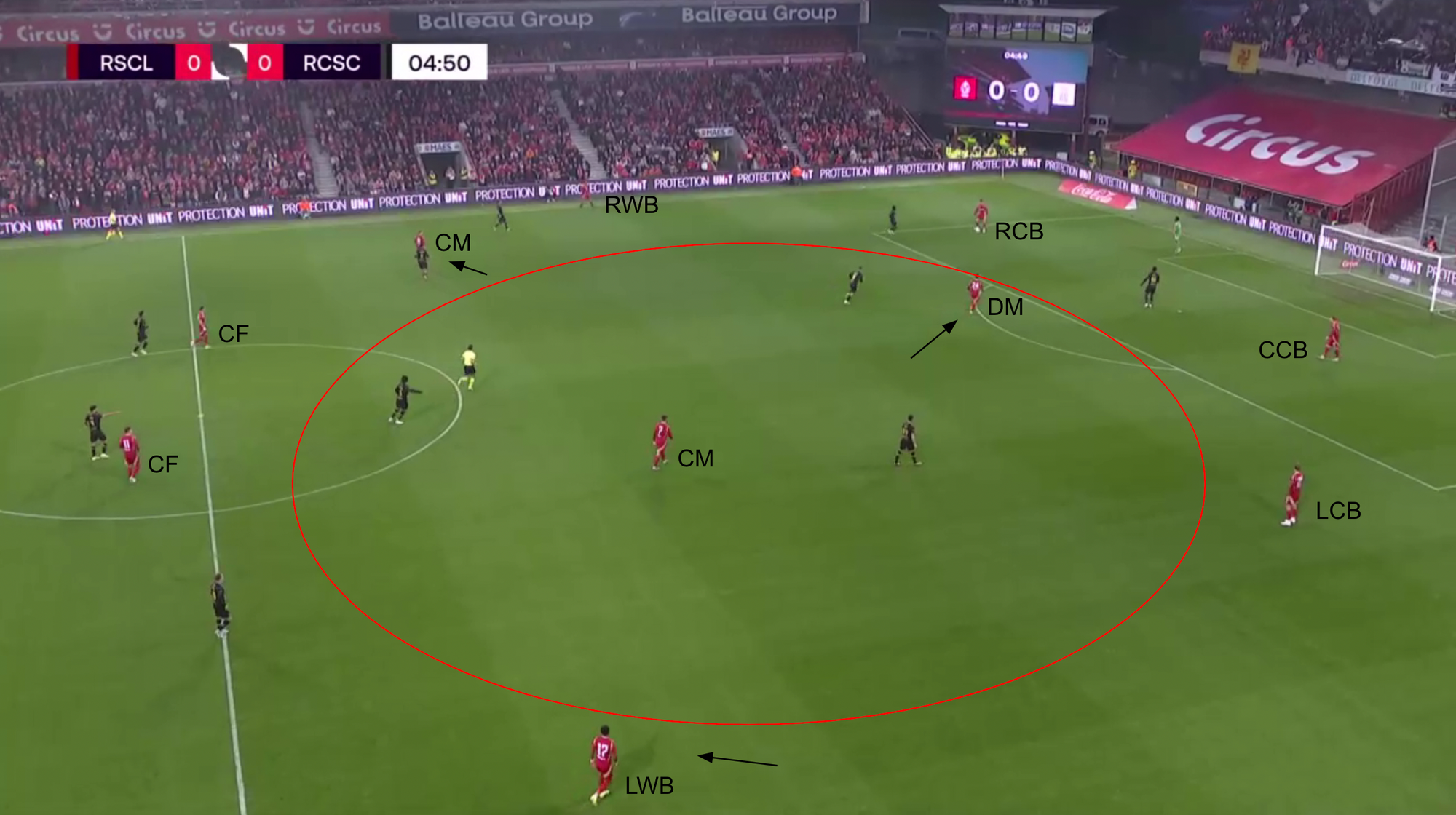
Here’s another example from the same game, about a minute later.
We can see the same issues again here.
Although Bulat is dropping a bit deeper to try to offer support, Standard is still heavily outnumbered in the area covered by the red circle again.
Here it would be almost impossible for Bulat to receive the ball without getting sucked into a Charleroi press from the players around him, and there aren’t any real avenues to go besides back to Epolo, who would have to go long for the player in possession here.
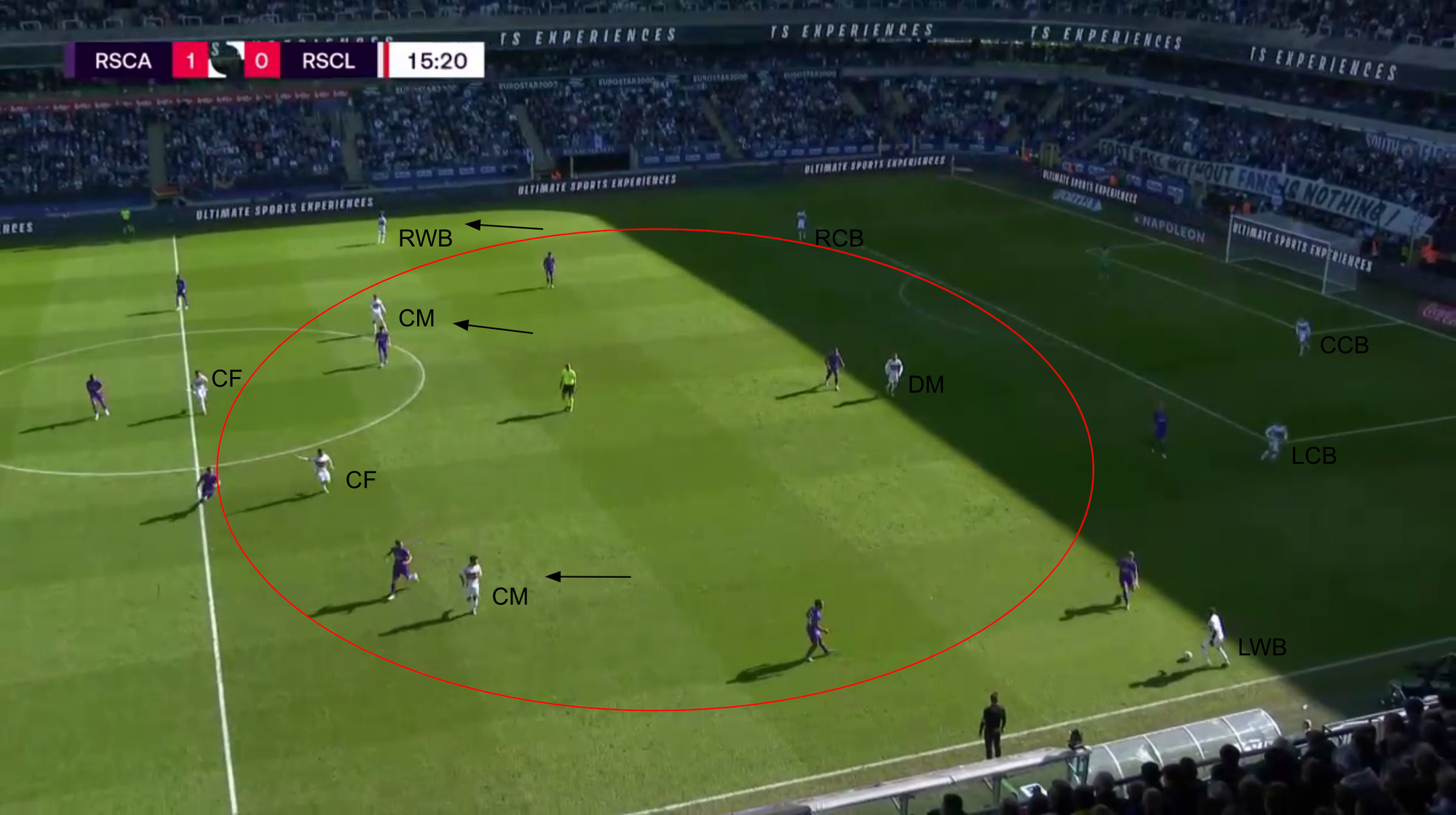
One more example of their poor spacing from the game against Anderlecht away, which admittedly is much tougher opposition than most this year.
But again, a lot of the same problems with their positional structure when in possession are on display here.
Here, we can see Camara on the ball in a deeper position with Fossey higher up on the opposite side to provide a further wide presence, but there is nowhere to go for Camara besides trying to play a risky pass with Anderlecht’s man-to-man coverage, shutting down any passing options close to him.
Under Ivan Leko’s coaching style, Standard have scored just one goal from open play due to their own build-up from the back. After eleven games, that is simply an appalling record for a club that should be among the top sides in Belgium.
And some of these issues covered here in this analysis have been a big reason why.
Wasteful Counters
Since Standard Liège is not built to outplay teams and keep the ball for long spells, their main offensive weapon has to be their counterattacking when they win balls back.
But with just one goal from a counterattack situation this season, it’s fair to say they’ve been wasteful in this area, too.
Here’s one such example below from the game against Royale Union SG.

This opportunity actually came about from a Union corner, and the leader of the counter ended up being Camara, who would probably be one of the better options as far as Standard is concerned.
There was a 4v2 opportunity to score close to halftime, but in the end, it culminated in a shot wide of the goal, which the goalkeeper comfortably saved.
Given the angle, it was a low xG value strike and, ultimately, a poor finishing sequence in a play that should have resulted in much more.
While Standard doesn’t regularly get such clear opportunities on the counter, it’s a sample of their profligacy in front of goal when they do present themselves and another reason for why their numbers are so low this cycle.
Conclusion
Standard Liège has the worst attack in the Belgian Jupiler Pro League so far this season, and this analysis has discussed some of the reasons why.
While things have been far from ideal, there are some encouraging signs since they’ve moved to a different shape that accommodates two forwards whilst keeping their pressing strategy intact.
But it’s very much still a work in progress.
It remains to be seen whether this will be enough to turn their fortunes around offensively under Ivan Leko tactics, who is in the hot seat given current results.
With four of their next six fixtures coming against sides below them in the table, perhaps this could be the opportunity they need to get those scoring boots on and firing going forward in the campaign.

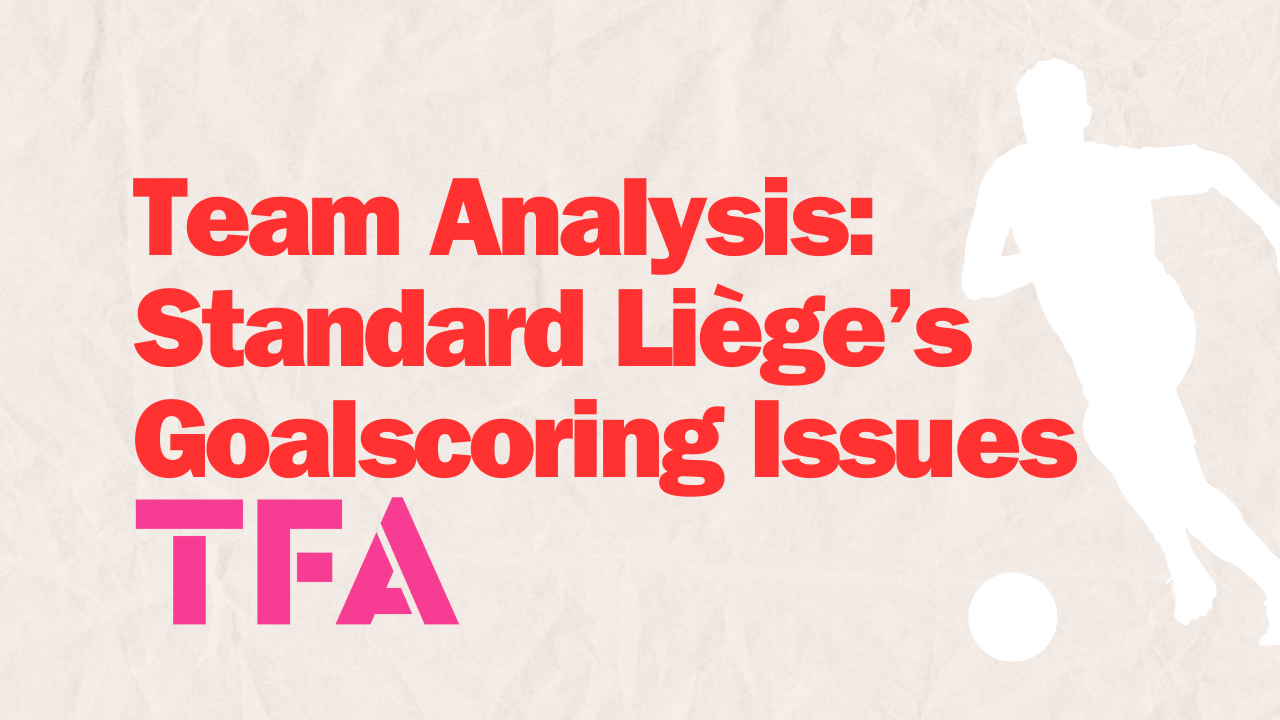




Comments